Having kids shouldn’t keep you from shooting stunning landscapes! Dylan Toh explains how he and his partner, Marianne Lim, combine the challenges of looking after a young family with pursuing their passion for photographing the great outdoors.
Marianne and I have been photographing landscapes seriously since 2008. We had been steadily adding images to our portfolio from our travels around the world and enjoying every minute of experiencing new and wonderful environments. But in 2010 we decided the timing was right to start a family. Prior to this big step we took a three-month holiday and literally had the photographic trip of our lives while visiting Iceland, Scotland and Nepal.
With the arrival of our first child in 2011 and then our second in 2014, we have since been trying to develop our photography while raising our two young children. It’s our hope that by experiencing nature from an early age, our children will grow up to appreciate and admire the natural world as much as we do. For this reason we have been trying to combine our family holidays with photography, always with our children’s safety and wellbeing as the priority. This dynamic may not work for some, but we believe it has allowed us to continue living life in as uninhibited a manner as possible while providing added experience for the children.
Here's an insight into some of our experiences regarding this challenging combination of child-raising and creating fine-art landscape photography.
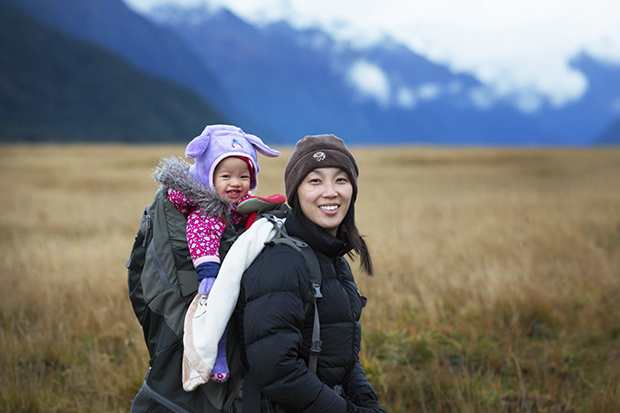
"We scouted this location while driving between Milford and Te Anau in New Zealand several times," Dylan Toh says. "Unfortunately light did not eventuate as we had hoped, but Charlotte certainly enjoyed her time out on this evening." Canon EOS 5D Mk II, 1/100s @ f/4, ISO 3200, handheld. Curves, contrast, colour adjustments in Photoshop CC.
THE RIGHT MINDSET
As most of our images are taken on dedicated photographic holidays, much of the following advice relates to trips away from home. As with any holiday, one’s frame of mind leading up to the trip is a very important factor. We try our best to avoid travel for travel’s sake, and treating a holiday as a home routine displaced by several thousand kilometres. You can’t expect that a photographic holiday with children will be as productive as one without them!
We’ve found that having high photographic expectations when visiting spectacular locations has only resulted in unwarranted disappointment. The combination of childrens’ activities and photography are all the more fulfilling if expectations are lower. Our first trip away with our baby Charlotte was when she was just five months old. This was to Kangaroo Island in South Australia, where we were staying in a two-bedroom apartment shared with visiting friends. We learned several important lessons from this trip.
We soon discovered our previous travelling style (dormitory/hostel accommodation) would probably not be suited to our needs! At home, we’d never co-slept with Charlotte and to change this routine for a few days was quite disruptive for both parent and child. We were frequently woken by noises in the night emanating from the nearby cot, while worrying that Charlotte might wake our friends in the next room. We were also travelling during summer, which meant that dawn and dusk shoots occurred during Charlotte’s sleeping hours. This required a lot of preparation and the development of supreme ‘stealth’ skills in order to avoid waking our hyper-vigilant child!
We learned from this trip that summer travelling with a young infant was not really conducive to photography during the “golden hours” due to interference with her natural sleep-wake cycle.
When she was five months of age we were prepared to try carrying Charlotte in a child carrier as she had good head control, and was physically big enough to fit. We gave priority to comfort (for us and Charlotte) and tolerability (by Charlotte) when choosing a carrier. So far we have not been disappointed with our Macpac Possum.
Our next major photographic journey was a three-week trip to New Zealand’s South Island when Charlotte was eight months old. This time we booked accommodation with two bedrooms where possible, and we also looked for places that were reasonably close to areas we wanted to visit. The timing of our visit in late April meant that shooting at dawn and dusk coincided with Charlotte’s usual sleep-wake cycle and fortuitously, the tail end of autumn colours. We were mindful however, that at the brink of the New Zealand winter, conditions could be quite cold at times and we made sure we had enough layers for her to stay warm. Our general rule was to provide her one more layer than what we planned to wear, given that she wasn’t involved with any activity during our shoots.
Where possible, we wanted to be right on the doorstep of locations so that we wouldn’t have to travel far to shoot or for a quick getaway if the conditions weren’t suitable. Examples of this included Lake Tekapo and Milford Sound, where we stayed within walking distance of fabulous opportunities. By the end of the trip, we found that we had settled into a routine of shooting late dawns and early dusks, commuting during the day to coincide with nap times and spending some family time together during wakeful daylight hours. We never considered doing any overnight hikes with Charlotte simply because of the impracticality of camping and the likely imposition on other hikers if she were to have a restless night in a tramper’s hut. As such I made two overnight trips by myself to Lake Mackenzie and Shallow Bay while Marianne was able to shoot closer locations such as Milford Sound and Lake Te Anau with Charlotte. This trip was a great success for us photographically as both of us were able to shoot at any given time and we felt it also laid the foundations for a travelling routine which our children have since adjusted to well.
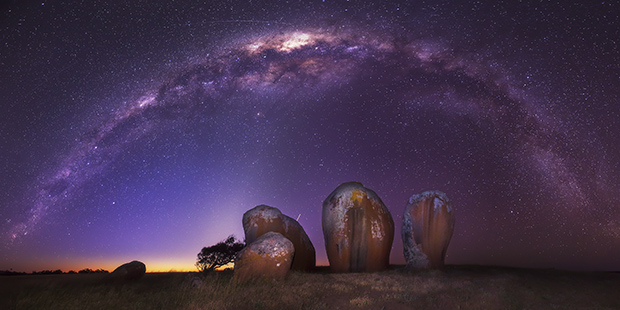
"This image was taken on a clear evening after Charlotte had fallen asleep," says Toh. "During early October the Milky Way was in a good position over the Haystacks with some zodiac lighting from beneath. I had one hour to get these images before a full moon was due to rise. Each image in the panorama was lit with a handheld torch rapidly flashing to and fro for approximately three seconds of each exposure." Canon EOS 5D Mk III, 30.0s @ f/3.2, ISO 3200, tripod. Thirteen vertical images stitched with 'Photomerge' curves, contrast, colour adjustments in Photoshop CC.
EXPANDING JOURNEYS
During the next year we made several shorter local outings to locations around South Australia like Eyre Peninsula and to the Limestone Coast. As Charlotte grew older two other issues became more noticeable than in the past. Firstly, as her mobility increased so did her own sense of adventure. As such we had to allow her more exploration time during our photographic outings. This meant that only one of us would be doing any dedicated shooting while the other would be entertaining/supervising her. Sometimes she would need both of our attentions and we often adapted our shooting style to suit. This would mean setting up scenes with long exposures in mind with a dense neutral density filter to allow interaction in between images. As a compromise it would also mean that at best, one of us would be shooting a particular scene at any given time. The other option was to shoot while she was asleep! As a result I began to delve more into astrophotography so I could shoot uninterrupted and undistracted, at the cost of sleep. The other issue was the attention span of a growing toddler during a road trip, with extended our driving periods. As a result, we tried to plan our trips so that commuting between any two locations was no longer than three or four hours under normal driving conditions. When a longer day was warranted, such as travelling from Glenorchy to Milford Sound (six hours) we included regular breaks to refresh both the drivers and the child. Generally we add approximately 50% more time to get to a given location when travelling with children.
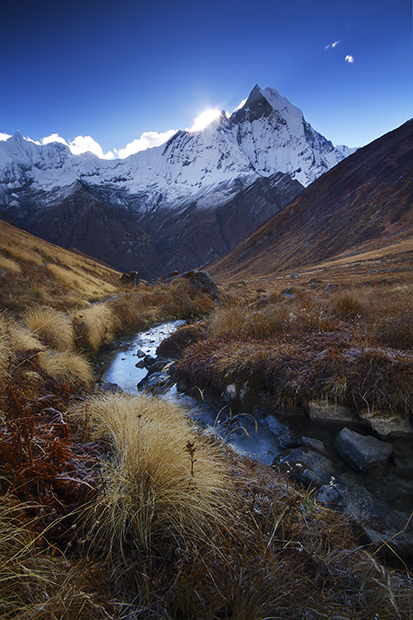
Marianne Lim: “This was taken before the sun rose above the distinctive Macchapuchhre (the Fish Tail Mountain) on the Annapurna Sanctuary Trek in Nepal, before we had children. I spent the night on a rock at 4100m, because at the Base Camp huts (4200m) my body was suffering from altitude sickness. We began our descent that morning, and I wanted to capture the stillness of the alpine wilderness before we left it behind.” Canon EOS 7D, 0.3s @ f/16, ISO 100, Gitzo tripod. Curves, contrast, colour adjustments in Photoshop CC.
ORGANISE A 'PLAN B'
Until the age of two, the farthest we had travelled was New Zealand. Then, the biggest trip occurred when Charlotte was two and I attended a work conference in Seattle on the northwest coast of the US. This gave us a great opportunity to photograph the pristine landscapes of the Pacific Northwest.
During this trip, we found that having a plan ‘B’ for poor health is important while travelling too! Unfortunately we had unknowingly contracted the flu immediately before our departure and this took its toll during our first week, where we were literally suffering from cabin fever at the foot of Mount Rainier, without much of a backup plan for less physical activities. Once we regained our health, we began to explore areas as a family with safety in mind given that at every location Charlotte wanted to be exploring the environment.
As a general rule, if there were any potential safety issues at any given location, we either did not take Charlotte (one parent would stay home or at another location with her while the other worked solo), or we would assess the environment thoroughly and make sure there was an alternative if it became unsuitable for a child (for example, rising tides when shooting seascapes).
Unless you’ve practiced the 'Twister' style positions that are often required to set up for a shot (with a weight on your back), trying it for the first time with a wriggling infant on your back is something we would strongly advise you do not attempt! On this particular trip there was far more solo shooting combined with caretaker duties than on our previous trip. At the age of two there were an incredible number of heart-warming moments during our daytime forays that we were constantly trying to capture.
As any parent knows, raising a child demands more time and energy than anything else, either vocational or educational. We found this to be the case while Marianne was pregnant with our second child.
We planned a short trip away by ourselves for the first time since we’d become parents, leaving Charlotte in the care of her grandparents. We immediately (re)discovered the enormous amount of freedom we had, though the days lacked the certain energy that only a two year old can bring. Despite being away for only three days, we added quite a few images to our portfolio from a weekend away to the Ocean Road, while shooting at a leisurely pace.
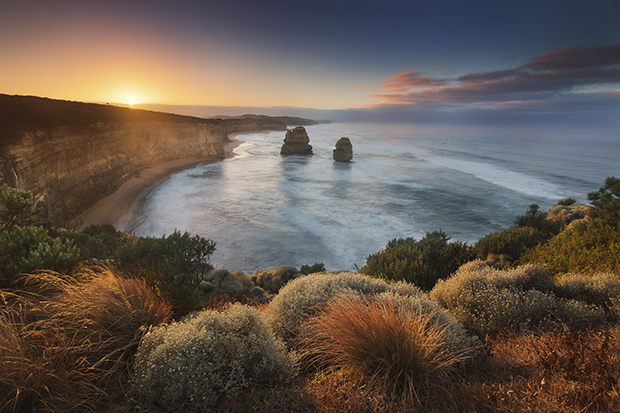
"This image was a tricky blend of several images," says Dylan Toh. "The foreground was taken immediately after sunrise with resultant flare affecting the rest of the image. It was taken at a relatively fast shutter and wider aperture and higher ISO than we would normally choose for a landscape due a breeze moving the foreground foliage. The rest of the image was blended with one exposure for the ocean before the sun had risen and was hence flare free. Another image was taken at the exact moment the sun was rising above the cliffs at f/16 for a good sun star." Canon EOS 5D Mk III, 1/6s @ f/9, ISO 800, Benro tripod. Image blending, curves, contrast, colour adjustments in Photoshop CC.
TIPS FOR A HAPPY CHILD
All parents know that a well-rested and well-fed child makes for a happy one! Always carry more snacks than you think you’ll need when you head out to shoot, preferably something small and easily given (think dried fruit, yoghurt buttons, muesli bars, crackers). If your child is very young, you may need to attach a toy to the carrier to entertain them if they are going to be carried for a long period of time. If your child is older, be prepared to take them out and let them explore, and put aside your camera for a time. You may need to pack portable activities such as colouring books, but the best entertainment is the environment. Get them involved looking for things like colourful leaves (in autumn), throwing small rocks into the river, making a cairn, collecting sticks, looking for – but not touching – mushrooms, or spotting insects or birds. Try to time photographic outings during their natural waking times, so plan a trip out just after they wake. Don’t try to do too much with young children – a typical outing for us involves driving or walking to a location, spending time photographing and exploring, having a meal break, then going back to our accommodation for a rest, or driving to our next location in preparation for the next shoot.
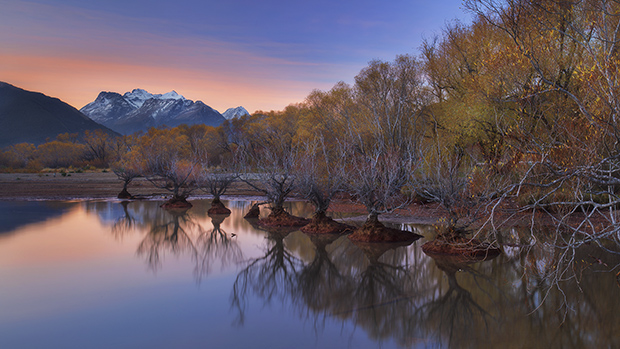
"This image was taken standing on the Glenorchy Jetty, NZ," says Marianne Lim. "I tried to look for a new composition and my eye kept settling on these trees with their curious bases. It was such a still evening I opted for a long exposure to smooth out the tiny ripples in the water." Canon EOS 5D Mk II, 15.0s @ f/16, ISO 50, Gitzo tripod. Curves, contrast, colour adjustments in Photoshop CC.
DOUBLE TROUBLE
In April last year our second child Jaime was born and it was at the tender age of six months that she undertook her first ‘photographic’ family holiday to New Zealand’s North Island. As with Charlotte, we did not co-sleep with Jaime, meaning that where possible we now required three-bedroom self-catering accommodation! We had previously struggled to fit our photographic gear and child equipment such as the carrier, pram and portacot into a rental SUV. For this trip we hired a Toyota Estima to comfortably fit all of our equipment, and therefore planned no off-road photographic locations.
We were travelling in October which meant that sunrise and sunset were before and after bedtimes respectively. This meant that our routine revolved around family time during the day and one of us heading off for a solo shoot before the children woke, or after their bedtime routines were complete.
To maximise our shooting opportunities we had to research locations as thoroughly as possible so we weren’t trying to make decisions on the fly. When we’re travelling without children it’s easy to quickly adapt our plans, depending on conditions, but for this trip we literally had planned a shoot based on our accommodation location and adhered to that schedule while hoping for favourable photographic conditions. If they were terrible, we’d save our energy and take the chance to rest. With two children, we learned that some remote locations such as Tongariro National Park are probably best left for when the children are older and capable of doing some walking!
We should point out this is a reflection on our personal experiences on combining early parenthood with landscape photography. Each of these activities individually can be tiring and demanding. The combination of the two has the potential to be exponentially more tiring, but with a positive frame of mind, attention to safety and detailed preparation, it can ultimately be a rewarding experience for the whole family. We hope we can update this article in several years’ time as we gain more experience with growing children. Oh, and the images that come from such journeys are pure serendipity!
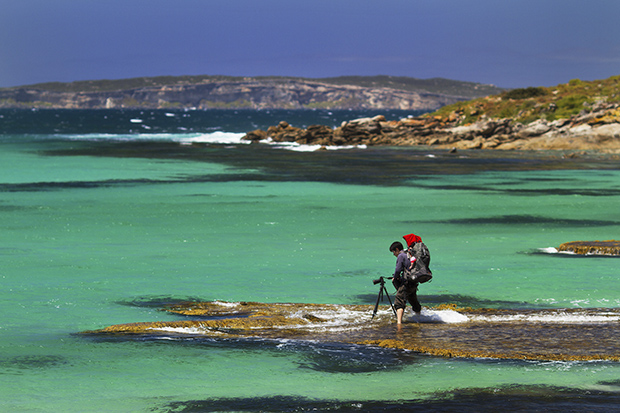
"The beautiful waters at Vivonne Bay in South Australia were stunningly vibrant on a cloudless day. Dylan’s penchant for getting his feet wet is captured in this image while Charlotte was suitably amused by the waters lapping around Dylan’s feet.” Canon EOS 7D, 1/800s @ f/3.2, ISO 100, handheld, polariser. Curves, contrast, colour adjustments in Photoshop CC.







